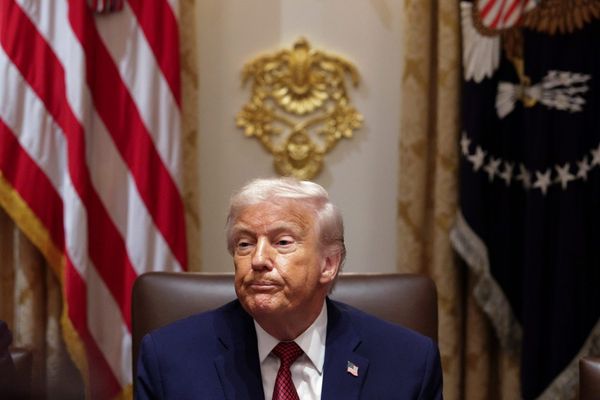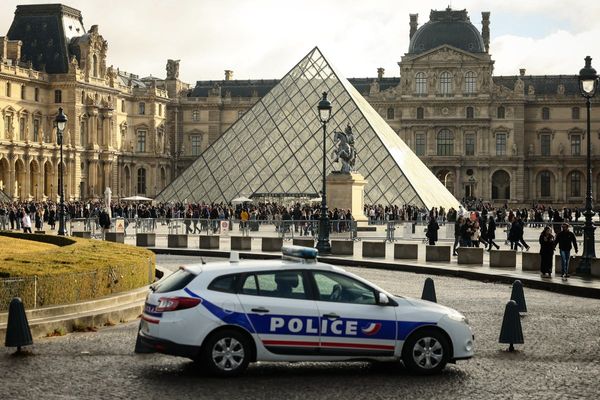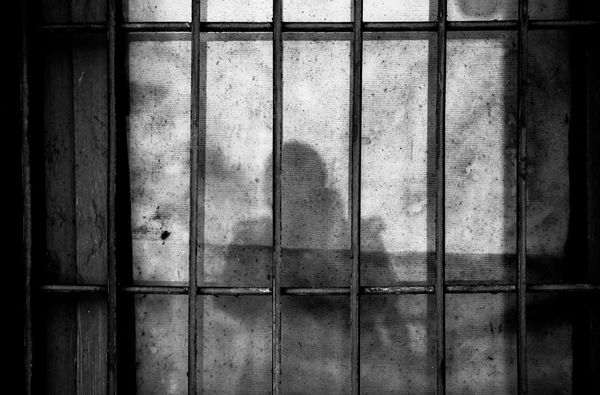
As protests in support of Palestine sweep university campuses across the US, student journalists from New York to Texas have documented the reality inside the encampments. They have risen to the occasion, capturing the quiet moments, the celebratory elements, the tense scenes and the violent police arrests.
We asked nine photographers – who have been covering the demonstrations at Columbia, Berkeley, the University of Texas and beyond – to tell the stories behind their most powerful photos.
***
Lily Speredelozzi | George Washington University
When a portion of the encampment at George Washington University was closed off by barriers, protesters outside chalked quotes such as “GW is complicit in genocide”, “shame on you GW”, and “power to the people”. Later, protesters broke down the barriers. I was excited to take this photo. I wanted to include context: the Palestinian flag, the students, the chalk. I love the overhead shot and the shadows. The GWU encampment protest has been peaceful, with GW police and DC Metro police presence but no activity.
***
Christian Harsa | The Lantern, Ohio State University
This photo was taken on the South Oval, across College Road from the Ohio Union. I wanted to get a shot of how police were making arrests so people could see what was happening on the ground. Adrenaline was running high because I was so close to where the police and the line of protesters met. The threat of being arrested myself was ever present. In this photo a student is being arrested after being brought to the ground and pulled from the line of protesters. I love the action this photo caught. I can’t help but put myself in her shoes and consider the anger and fear she must have felt.
***
Krish Dev | Washington Square News, New York University
This was taken on the evening of 25 April, right before more than 100 students formed a picket line outside Gould Plaza to protest the 120 arrests of protesters, including students and faculty, at the site three days earlier. I saw police aggressively charge at protesters in riot gear and zip-tie them; they even pepper-sprayed one of our photographers. Following the arrests, police constructed a wall using metal boards and plastic barriers. Some wrote messages and attached flyers calling on students to go to Columbia University to support the encampment there. The person who is looking at the board in the image is a campus safety officer. Campus safety officers have been guarding the protests 24/7 over the past week and, in my experience, have been respectful of demonstrations and kept protesters safe from those outside. Originally, I was planning to take a photo of the wooden board and the words “WALL OF SHAME” written on it. As I was taking the photo, a campus safety officer started to look at the message. I thought the juxtaposition between him and the message was very powerful. I felt a little sad for the officer, who looked slightly upset in the shot. I’ve seen multiple campus safety officers who appear conflicted. I was also reminded of the violation of student trust taking place on campus.
***
Anita Liu | The Daily Californian, University of California, Berkeley
This picture was taken from the balcony of the Martin Luther King Jr student union building, which is directly opposite the encampment. It’s a common location to take protest photos, to show a wider perspective. There were approximately 150 tents and no police activity at the time. The steps were named after a leader of the free speech movement, making the encampment grounds an important site in political activism.
When taking this photo, I knew I was documenting an important moment in campus history. I couldn’t help but think about the parallels between the Free Palestine encampment and the South African apartheid demonstrations on campus back in the 1980s.
***
Charlotte Keene | The Daily Texan, University of Texas, Austin
After protest and police interactions got more hectic, many students started running away.
Another photographer and I ran into this building after police started using force to disperse the crowd. We knew we had to do more than hide, so we started looking for classrooms with windows. We heard the commotion coming from the bottom floor exits. And then we saw the scene.
I was scared. I almost did not take it. Those of us in the building were unsure whether the police would force their way in. But I stopped for a second and knew I needed to capture what I was seeing.
I love the symmetry. I think there is something pleasant to look at about the contrast in light and the repetitive squares from the window – almost as if there is a sense of calm before the storm. To me, the stillness reads as anticipation.
***
Marco Postigo Storel | Columbia University
Different groups within the Gaza Solidarity encampment at Columbia University were having a dance presentation inside the encampment during a warm afternoon. I decided to lie down on the grassy ground in the center of the circle, and get their feet in the foreground while the rest of the people were moving in the background. It was a warm day with good lighting.
I like how everything in the frame is at the right spot at the right time, and the three-dimensionality that the photo has makes it better. Like a finished puzzle. I got a lot of dirt on my clothes by taking this photo, but it was worth it.
***
Manoo Sirivelu | The Daily Texan, University of Texas at Austin
In this picture, University of Texas police (UTPD) officers are pinning a protester on the concrete sidewalk and zip-tying them. Law enforcement would push in at intervals and surround the protesters, 360 degrees. Nearby crowds and media often couldn’t see the full extent of the force used and how the protesters were being detained. I wanted to show the feelings of imprisonment and suffocation that the students were experiencing, so I tried to depict the officers’ legs as bars that were already surrounding the student.
I was beside the student in this picture when the arrest was made and a UTPD officer had pushed me down while trying to make space. I was lying on the ground with a wall of cops between me and the student when I sat up to take this picture, not more than five feet away from her.
I was shocked from being pushed to the ground when I met her gaze and realized we were close enough to make eye contact. I felt needed to take a picture that would encapsulate both her feelings and my own.
It shows how unnecessary the force used in these arrests was. Our cameras bear the responsibility of recording the events – to allow the viewers to see, and, most importantly, place themselves in our point of view with a space for empathy that a photo like this provides.
***
Jason Alpert-Wisnia | Washington Square News, New York University
In this photograph, students were eating donated and purchased food. They had supplies gathered in the center of their space and students would sit around by their tents there to eat. I wanted to show the stillness, in between the moments of action that are everywhere. Shooting from above gives scale to the campus protests. I took this from the third floor of NYU’s Paulson Center looking down on the camp. As a student I can enter buildings and work from angles that non-students cannot, so I had the advantage of height.
***
Top Image:
Lorianne Willett | The Daily Texan, University of Texas, Austin
I was looking to tell the stories of students being arrested. When I took this picture, I was standing just in front of state troopers who’d surrounded the van they were putting arrested people in. I was in the front of a large crowd of people protesting and spectating. After going through my take, I really felt so affected by seeing the faces of people my age being taken to jail. In this shot, I like the framing of arrested protesters in between the helmets of state troopers.







